As a parent of two neurodivergent kids myself and one child with PANS, witnessing your child struggle with Pediatric Acute-Onset Neuropsychiatric Syndrome (PANS) or Pediatric Autoimmune Neuropsychiatric Disorders Associated with Streptococcal Infections (PANDAS) can be incredibly distressing.
These conditions are characterized by sudden-onset obsessive-compulsive disorder (OCD), tics, anxiety, and other neuropsychiatric symptoms following a streptococcal infection, tick-borne infection or other environmental triggers.
Since so many of the individuals I work with are affected by neuroinflammation due to infections such as Lyme, bartonella, babesiosis, strep, Epstein-Barr, etc, finding treatments that combat brain inflammation is critical. Low Dose Naproxen is a treatment that many of my clients use in their healing journey.
The Naproxen Prescription for PANS/PANDAS
Seeking effective treatments becomes a priority, and one such treatment that has shown promise in managing symptoms is low dose Naproxen. Naproxen, often known by its brand name Aleve, is a nonsteroidal anti-inflammatory drug (NSAID). Aleve, and also Advil, are used primarily to reduce pain, inflammation, and fever.
It works by inhibiting the production of prostaglandins, the chemicals in the body that contribute to pain and inflammation. Naproxen is available in various forms, including tablets, capsules, and liquid suspension, and can be purchased over the counter or prescribed by a healthcare provider.
The Role of Naproxen Usage in PANS and PANDAS
In the context of PANS and PANDAS, the use of low dose naproxen aims to alleviate symptoms associated with inflammation and immune dysregulation. While the exact mechanisms underlying these conditions are still under investigation, it's believed that inflammatory processes play a significant role in the manifestation of neuropsychiatric symptoms.

A noteworthy study conducted by Brown et al. in 2017 provided valuable insights into using naproxen for treating PANS and PANDAS. This randomized, placebo-controlled clinical trial examined the effects of NSAIDs, including naproxen, when administered before symptoms started or soon after their onset in children with PANS or PANDAS.
The study found promising results, suggesting that early intervention with NSAIDs like Advil or Aleve could potentially shorten the duration of neuropsychiatric symptoms in children affected with PANS/PANDAS.
These findings show that considering naproxen as part of a comprehensive treatment approach for PANS and PANDAS could be helpful, as it has the potential to address underlying inflammatory processes and improve symptom management.
Many of my clients often make the connection to PANS-PANDAS when they notice behavioral improvements after using naproxen.
Naproxen Sodium Dosage and Administration
When considering the use of naproxen for PANS and PANDAS, it's crucial to adhere to proper dosage guidelines and always check with your physician. Typically, a low dose of naproxen is recommended, often starting at 10 mg/kg per dose, not exceeding 500 mg per dose or 1000 mg per day (Gagliano et al., 2023).
Clinical recommendations for diagnosing and treating PANS in European Nordic countries suggest using oral NSAIDs like Ibuprofen (10–15 mg/kg/dose, three times a day, maximum 500 mg/dose) or Naproxen (10–20 mg/kg/day split into two doses, maximum 500 mg twice a day). It's advised to assess the treatment's effectiveness after 4 weeks and continue it for up to 12 weeks if necessary (Gagliano et al., 2023).
However, dosing should always be individualized based on the child's age, weight, and overall health status, and it's essential to consult with a qualified healthcare provider before initiating NSAIDs for PANS/PANDAS treatment.

Combination Therapy and Safety Considerations
When doctors prescribe naproxen as part of a treatment plan for PANS or PANDAS, they might also recommend other medications and therapies to help manage symptoms effectively. This combination approach, known as combination therapy, can be beneficial in providing comprehensive care for your child.
However, parents need to be cautious when their child is taking naproxen along with other medications. Certain combinations, especially with other NSAIDs (like Ibuprofen) or anticoagulants (medicines that prevent blood clots), can increase the risk of harmful side effects such as bleeding in the stomach or kidney problems.
In addition to pharmacological interventions like naproxen, a comprehensive treatment plan should also include at least 40 sessions of neurofeedback and 13 sessions of PEMF combined with biofeedback. Somatic therapy and parent coaching complete the combination.
The synergistic effects of these therapies resulted in significant improvements for Maya, one of the PANS/PANDAS kids I treated. We have seen more than 50% reduction in overactive brain wave activity, particularly in Delta and Beta frequencies.
Behaviorally, Maya experienced a notable decrease in emotional and behavioral outbursts, from at least three episodes a day to one every seven to ten days, with reduced intensity and duration.
Furthermore, Maya was able to actively engage in counseling sessions, implement dietary and lifestyle changes, and successfully reintegrate into school through a tiered return approach. This holistic approach demonstrates the effectiveness of combining various therapeutic modalities to address the complex needs of individuals like Maya. Read the case study here.
Naproxen Indications, Monitoring, and Side Effects
As a parent, it's crucial to keep a close eye on your child's well-being while they are taking their prescription naproxen dose. Although naproxen is usually well-tolerated, be sure to watch out for any signs of potential side effects, particularly if your child is using it for an extended period.
Common side effects of naproxen can include stomach upset, nausea, headache, dizziness, or drowsiness. These side effects are typically mild and temporary, but parents must be aware of them nonetheless. If your child experiences any of these symptoms, provide comfort and seek support while also monitoring their condition closely.
Low dose Naproxen and Holistic Therapy
In the management of PANS and PANDAS, the use of low dose naproxen can be a valuable tool in reducing inflammation and alleviating neuropsychiatric symptoms when used under the care of a provider . However, it's essential to approach treatment holistically and comprehensively.
Incorporating therapy, and lifestyle interventions tailored to your child's specific needs. Work closely with a knowledgeable healthcare provider to develop a comprehensive treatment plan that maximizes the benefits of the right naproxen dosage while minimizing the risk of adverse effects.
Our BrainBehaviorResetTM Program does all these. Remember that the ultimate goal is to help your child achieve better symptom control and improved quality of life. To know more about PANS and PANDAS, download this diagnostic checklist used by healthcare providers.
Is Naproxen 500 mg a strong painkiller?
Naproxen 500mg is considered a potent pain reliever within the class of nonsteroidal anti-inflammatory drugs. However, its effectiveness can vary depending on individual factors such as the type and severity of the condition. Consult your physician.
How strong is naproxen?
Naproxen is a potent nonsteroidal anti-inflammatory drug (NSAID) commonly used to relieve pain and inflammation. Its strength lies in its ability to effectively reduce pain associated with conditions such as arthritis, menstrual cramps, and other inflammatory conditions.
Can I take 2 Aleve at once?
It is generally recommended to follow the dosing instructions on the packaging or as directed by a healthcare provider. Taking two Aleve tablets at once may exceed the recommended dosage and could increase the risk of side effects such as stomach upset or gastrointestinal bleeding.
How many Aleve can I take?
It is generally recommended to follow the dosing instructions on the packaging or as directed by a healthcare provider. Taking two Aleve tablets at once may exceed the recommended dosage and could increase the risk of side effects such as stomach upset or gastrointestinal bleeding.
How often can you take Aleve?
A typical Aleve dosage is usually taken every 8 to 12 hours as needed for pain relief. However, it's essential to follow the dosing instructions on the packaging or as advised by a healthcare provider to ensure safe and effective use.
How long does naproxen take to kick in?
Naproxen sodium typically starts to work within 30 minutes to 1 hour after taking it. However, the full effects may not be felt until several hours after administration.
Can I take Aleve and Tylenol together?
It is generally safe to take Aleve or any naproxen and Tylenol together, as they belong to different classes of pain relievers. However, it's advisable to consult with a healthcare provider before combining medications to ensure safety and effectiveness, especially if you have any underlying health conditions or are taking other medications.
How many Aleve 220 mg can I take?
The recommended dosage for Aleve is typically one tablet (of naproxen sodium 220 mg) every 8 to 12 hours as needed for pain relief. It's essential to follow the dosing instructions on the packaging or as advised by a healthcare provider to avoid exceeding the maximum daily dose and minimize the risk of side effects.
Is it safe to take Aleve every day for arthritis?
Taking Aleve daily for arthritis pain relief can be safe for some individuals, but it's essential to do so under the guidance of a healthcare provider. Prolonged or excessive use of Aleve can increase the risk of side effects such as gastrointestinal bleeding or kidney problems, so it's crucial to use it as directed and monitor for any adverse reactions.
How long does Aleve last?
The effects of Aleve typically last for around 8 to 12 hours after taking a dose. However, individual responses to the medication may vary, and the duration of pain relief may differ depending on factors such as the type and severity of pain.
What is naproxen 500 mg effect on a person?
Naproxen 500 mg can provide effective pain relief and reduce inflammation when used as directed by a healthcare provider. However, it's essential to use caution and follow dosing guidelines carefully to minimize the risk of side effects, especially in younger children.
Can I take acetaminophen with naproxen?
It is generally safe to take acetaminophen (Tylenol) with naproxen tablets, but it's crucial to consult with a healthcare provider before combining medications. They can provide personalized guidance based on your medical history and ensure that the combination is safe and effective for you.
Is naproxen for tooth pain?
Naproxen can be used to relieve tooth pain, as it is an effective nonsteroidal anti-inflammatory drug (NSAID) that reduces inflammation and provides pain relief. However, it's essential to consult with a dentist or healthcare provider for proper diagnosis and treatment recommendations for a toothache tablet tailored to your specific dental condition.
Is naproxen sodium good for period cramps?
Yes, naproxen sodium, commonly found in medications like Aleve, is often used to relieve period cramps. It works as a nonsteroidal anti-inflammatory drug (NSAID) to reduce inflammation and alleviate pain associated with menstrual cramps. Consult your provider.
Citations
Brown, K. D., Farmer, C., Freeman, G. M., Spartz, E. J., Farhadian, B., Thienemann, M., & Frankovich, J. (2017). Effect of Early and Prophylactic Nonsteroidal Anti-Inflammatory Drugs on Flare Duration in Pediatric Acute-Onset Neuropsychiatric Syndrome: An Observational Study of Patients Followed by an Academic Community-Based Pediatric Acute-Onset Neuropsychiatric Syndrome Clinic. Journal of Child and Adolescent Psychopharmacology, 27(7), 619–628. https://doi.org/10.1089/cap.2016.0193
Gagliano, A., Carta, A., Tanca, M. G., & Stefano Sotgiu. (2023). Pediatric Acute-Onset Neuropsychiatric Syndrome: Current Perspectives. Neuropsychiatric Disease and Treatment, Volume 19(2023), 1221–1250. https://doi.org/10.2147/ndt.s362202
Dr. Roseann is a mental health expert in PANS/PANDAS who frequently is in the media:
- Healthy Parenting Connector (Video) Why “My Kid is Acting Crazy” Might be PANS/PANDAS
- Living with Lyme (Podcast) Neurofeedback and biofeedback for PANS/PANDAS
- Maria Rickert Hong (Audio) PANS/PANDAS
Always remember… “Calm Brain, Happy Family™”
Disclaimer: This article is not intended to give health advice and it is recommended to consult with a physician before beginning any new wellness regime. *The effectiveness of diagnosis and treatment vary by patient and condition. Dr. Roseann Capanna-Hodge, LLC does not guarantee certain results.
Are you looking for SOLUTIONS for your struggling child or teen?
Dr. Roseann and her team are all about science-backed solutions, so you are in the right place!
Discover 10 Natural Solutions and Treatments for PANS/PANDAS To Help Your Child Get Unstuck
Dr. Roseann is a Children’s Mental Health Expert and Licensed Therapist who has been featured in/on hundreds of media outlets including The Mel Robbins Show, CBS, NBC, PIX11 NYC, Today, FORBES, CNN, The New York Times, The Washington Post, Business Insider, Women’s Day, Healthline, CNET, Parade Magazine and PARENTS. FORBES called her, “A thought leader in children’s mental health.”

She coined the terms, “Re-entry panic syndrome” and “eco-anxiety” and is a frequent contributor to media on mental health.
Dr. Roseann Capanna-Hodge has three decades of experience in working with children, teens and their families with attention-deficit hyperactivity disorder (ADHD), autism, concussion, dyslexia and learning disability, anxiety, Obsessive Compulsive Disorder (OCD), depression and mood disorder, Lyme Disease, and PANS/PANDAS using science-backed natural mental health solutions such as supplements, magnesium, nutrition, QEEG Brain maps, neurofeedback, PEMF, psychotherapy and other non-medication approaches.
She is the author of three bestselling books, It’s Gonna Be OK!: Proven Ways to Improve Your Child's Mental Health, The Teletherapy Toolkit, and Brain Under Attack. Dr. Roseann is known for offering a message of hope through science-endorsed methods that promote a calm brain.
Her trademarked BrainBehaviorResetⓇ Program and It’s Gonna be OK!Ⓡ Podcast has been a cornerstone for thousands of parents facing mental health, behavioral or neurodevelopmental challenges.
She is the founder and director of The Global Institute of Children’s Mental Health, Neurotastic™Brain Formulas and Dr. Roseann Capanna-Hodge, LLC. Dr. Roseann is a Board Certified Neurofeedback (BCN) Practitioner, a Board Member of the Northeast Region Biofeedback Society (NRBS), Certified Integrative Mental Health Professional (CIMHP) and an Amen Clinic Certified Brain Health Coach. She is also a member of The International Lyme Disease and Associated Disease Society (ILADS), The American Psychological Association (APA), Anxiety and Depression Association of America (ADAA) National Association of School Psychologists (NASP), International OCD Foundation (IOCDF).
© Roseann-Capanna-Hodge, LLC 2024










